Enterprise Architecture: Analysis of Three Business Organizations
VerifiedAdded on 2023/01/11
|13
|2742
|45
Report
AI Summary
This report provides an in-depth analysis of Enterprise Architecture (EA) across three distinct business organizations: SteelCo, MultiCorp, and FinCorp. The report begins by defining EA and its strategic importance in aligning IT operations with business goals. It then delves into three case studies, examining SteelCo's architecture structure and required enterprise architects, MultiCorp's operating model, standardized processes, data integration, and IT landscape, and FinCorp's EA tool challenges, value, and alignment strategies. The report assesses the EA efforts, IT infrastructure, and alignment issues of each company, offering insights into the effective implementation of EA to enhance performance, efficiency, and productivity. It also explores the value of EA tools and provides recommendations for maximizing their impact. The report concludes by summarizing the key findings and emphasizing the importance of strategic alignment between business and IT operations.

Report
Paraphrase This Document
Need a fresh take? Get an instant paraphrase of this document with our AI Paraphraser
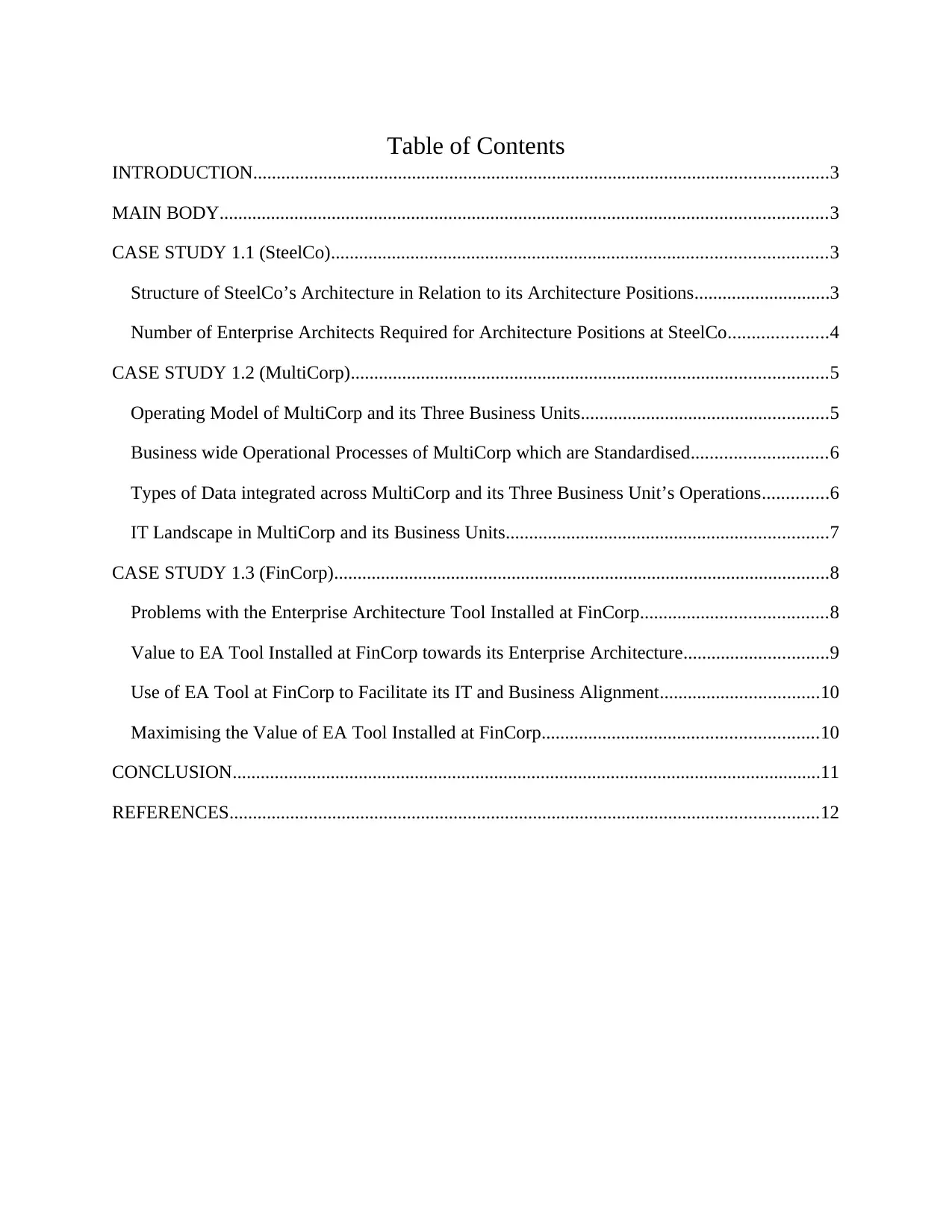
Table of Contents
INTRODUCTION...........................................................................................................................3
MAIN BODY..................................................................................................................................3
CASE STUDY 1.1 (SteelCo)..........................................................................................................3
Structure of SteelCo’s Architecture in Relation to its Architecture Positions.............................3
Number of Enterprise Architects Required for Architecture Positions at SteelCo.....................4
CASE STUDY 1.2 (MultiCorp)......................................................................................................5
Operating Model of MultiCorp and its Three Business Units.....................................................5
Business wide Operational Processes of MultiCorp which are Standardised.............................6
Types of Data integrated across MultiCorp and its Three Business Unit’s Operations..............6
IT Landscape in MultiCorp and its Business Units.....................................................................7
CASE STUDY 1.3 (FinCorp)..........................................................................................................8
Problems with the Enterprise Architecture Tool Installed at FinCorp........................................8
Value to EA Tool Installed at FinCorp towards its Enterprise Architecture...............................9
Use of EA Tool at FinCorp to Facilitate its IT and Business Alignment..................................10
Maximising the Value of EA Tool Installed at FinCorp...........................................................10
CONCLUSION..............................................................................................................................11
REFERENCES..............................................................................................................................12
INTRODUCTION...........................................................................................................................3
MAIN BODY..................................................................................................................................3
CASE STUDY 1.1 (SteelCo)..........................................................................................................3
Structure of SteelCo’s Architecture in Relation to its Architecture Positions.............................3
Number of Enterprise Architects Required for Architecture Positions at SteelCo.....................4
CASE STUDY 1.2 (MultiCorp)......................................................................................................5
Operating Model of MultiCorp and its Three Business Units.....................................................5
Business wide Operational Processes of MultiCorp which are Standardised.............................6
Types of Data integrated across MultiCorp and its Three Business Unit’s Operations..............6
IT Landscape in MultiCorp and its Business Units.....................................................................7
CASE STUDY 1.3 (FinCorp)..........................................................................................................8
Problems with the Enterprise Architecture Tool Installed at FinCorp........................................8
Value to EA Tool Installed at FinCorp towards its Enterprise Architecture...............................9
Use of EA Tool at FinCorp to Facilitate its IT and Business Alignment..................................10
Maximising the Value of EA Tool Installed at FinCorp...........................................................10
CONCLUSION..............................................................................................................................11
REFERENCES..............................................................................................................................12

INTRODUCTION
Enterprise Architecture (EA) is a strategic business process through which business
organisations can standardise, organise and update their business IT operations, infrastructure
and processes with the intention to align them with the end objectives and goals of the
organisation so that they can be achieved in an effective and efficient manner (Hansen and
Hacks, 2017). Business organisations make use of Enterprise Architecture to modernise its IT
infrastructure, operations, hardware and processes, so that their IT department can be digitally
transformed making the business organisation capable of performing with increased
performance, efficiency, thus providing it with enhanced productivity and profitability in the
consumer markets. This report assesses the EA efforts and issues of three business organisations.
MAIN BODY
CASE STUDY 1.1 (SteelCo)
Structure of SteelCo’s Architecture in Relation to its Architecture Positions
In order to effectively improve its current IT infrastructure, policies, processes and
operations conducted by its two operational divisions Alpha and Beta, SteelCo needs to
effectively implement Enterprise architecture into the operations and functions of its two
Enterprise Architecture (EA) is a strategic business process through which business
organisations can standardise, organise and update their business IT operations, infrastructure
and processes with the intention to align them with the end objectives and goals of the
organisation so that they can be achieved in an effective and efficient manner (Hansen and
Hacks, 2017). Business organisations make use of Enterprise Architecture to modernise its IT
infrastructure, operations, hardware and processes, so that their IT department can be digitally
transformed making the business organisation capable of performing with increased
performance, efficiency, thus providing it with enhanced productivity and profitability in the
consumer markets. This report assesses the EA efforts and issues of three business organisations.
MAIN BODY
CASE STUDY 1.1 (SteelCo)
Structure of SteelCo’s Architecture in Relation to its Architecture Positions
In order to effectively improve its current IT infrastructure, policies, processes and
operations conducted by its two operational divisions Alpha and Beta, SteelCo needs to
effectively implement Enterprise architecture into the operations and functions of its two
⊘ This is a preview!⊘
Do you want full access?
Subscribe today to unlock all pages.

Trusted by 1+ million students worldwide
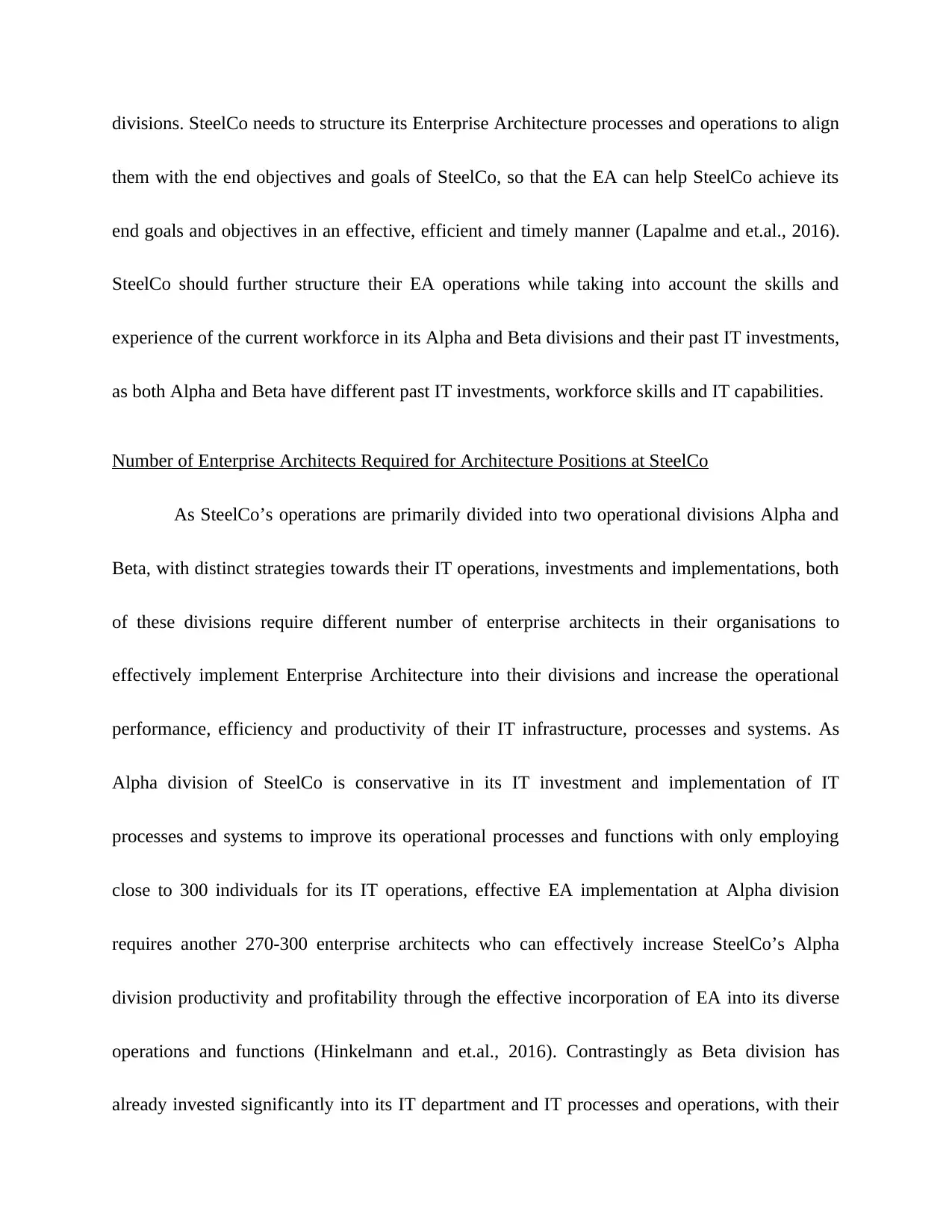
divisions. SteelCo needs to structure its Enterprise Architecture processes and operations to align
them with the end objectives and goals of SteelCo, so that the EA can help SteelCo achieve its
end goals and objectives in an effective, efficient and timely manner (Lapalme and et.al., 2016).
SteelCo should further structure their EA operations while taking into account the skills and
experience of the current workforce in its Alpha and Beta divisions and their past IT investments,
as both Alpha and Beta have different past IT investments, workforce skills and IT capabilities.
Number of Enterprise Architects Required for Architecture Positions at SteelCo
As SteelCo’s operations are primarily divided into two operational divisions Alpha and
Beta, with distinct strategies towards their IT operations, investments and implementations, both
of these divisions require different number of enterprise architects in their organisations to
effectively implement Enterprise Architecture into their divisions and increase the operational
performance, efficiency and productivity of their IT infrastructure, processes and systems. As
Alpha division of SteelCo is conservative in its IT investment and implementation of IT
processes and systems to improve its operational processes and functions with only employing
close to 300 individuals for its IT operations, effective EA implementation at Alpha division
requires another 270-300 enterprise architects who can effectively increase SteelCo’s Alpha
division productivity and profitability through the effective incorporation of EA into its diverse
operations and functions (Hinkelmann and et.al., 2016). Contrastingly as Beta division has
already invested significantly into its IT department and IT processes and operations, with their
them with the end objectives and goals of SteelCo, so that the EA can help SteelCo achieve its
end goals and objectives in an effective, efficient and timely manner (Lapalme and et.al., 2016).
SteelCo should further structure their EA operations while taking into account the skills and
experience of the current workforce in its Alpha and Beta divisions and their past IT investments,
as both Alpha and Beta have different past IT investments, workforce skills and IT capabilities.
Number of Enterprise Architects Required for Architecture Positions at SteelCo
As SteelCo’s operations are primarily divided into two operational divisions Alpha and
Beta, with distinct strategies towards their IT operations, investments and implementations, both
of these divisions require different number of enterprise architects in their organisations to
effectively implement Enterprise Architecture into their divisions and increase the operational
performance, efficiency and productivity of their IT infrastructure, processes and systems. As
Alpha division of SteelCo is conservative in its IT investment and implementation of IT
processes and systems to improve its operational processes and functions with only employing
close to 300 individuals for its IT operations, effective EA implementation at Alpha division
requires another 270-300 enterprise architects who can effectively increase SteelCo’s Alpha
division productivity and profitability through the effective incorporation of EA into its diverse
operations and functions (Hinkelmann and et.al., 2016). Contrastingly as Beta division has
already invested significantly into its IT department and IT processes and operations, with their
Paraphrase This Document
Need a fresh take? Get an instant paraphrase of this document with our AI Paraphraser
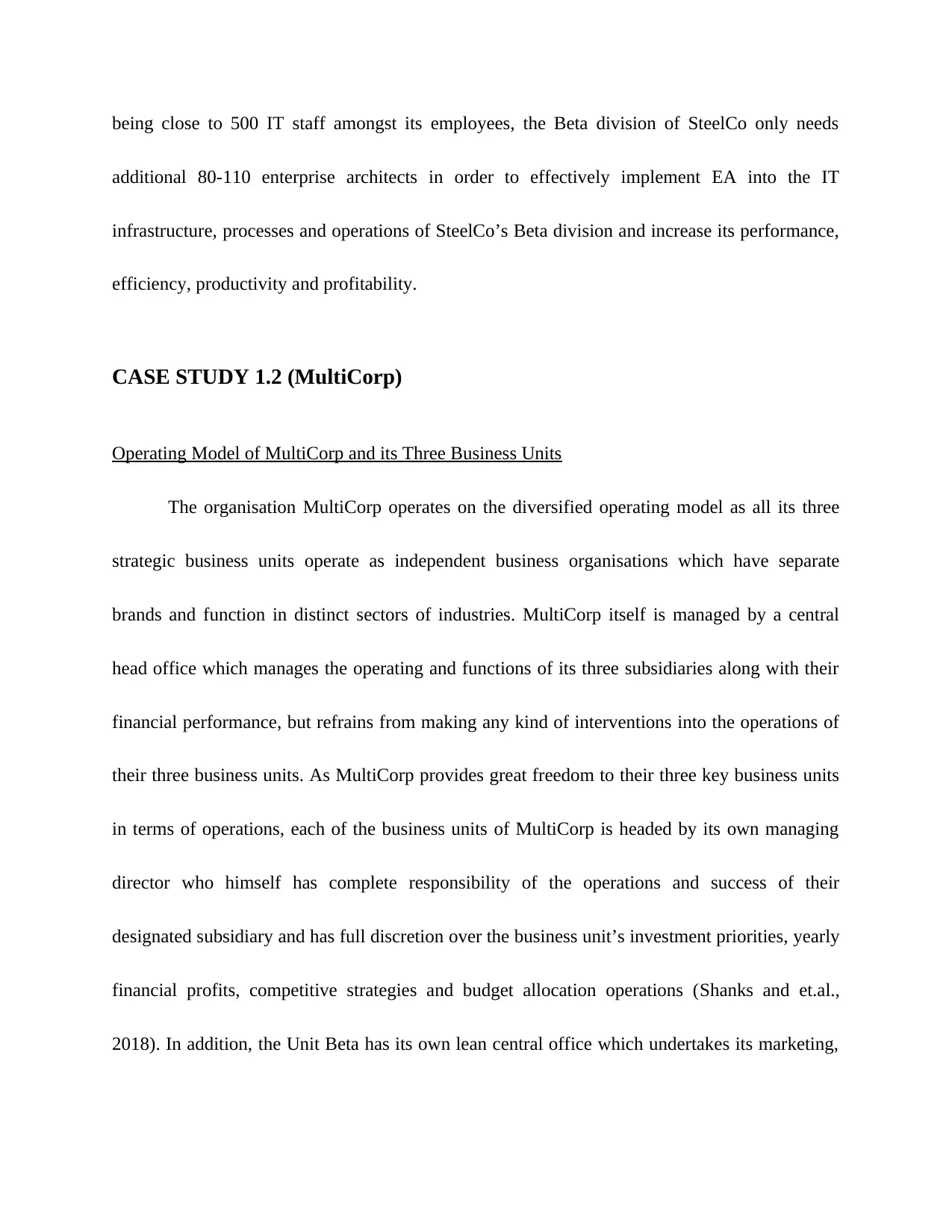
being close to 500 IT staff amongst its employees, the Beta division of SteelCo only needs
additional 80-110 enterprise architects in order to effectively implement EA into the IT
infrastructure, processes and operations of SteelCo’s Beta division and increase its performance,
efficiency, productivity and profitability.
CASE STUDY 1.2 (MultiCorp)
Operating Model of MultiCorp and its Three Business Units
The organisation MultiCorp operates on the diversified operating model as all its three
strategic business units operate as independent business organisations which have separate
brands and function in distinct sectors of industries. MultiCorp itself is managed by a central
head office which manages the operating and functions of its three subsidiaries along with their
financial performance, but refrains from making any kind of interventions into the operations of
their three business units. As MultiCorp provides great freedom to their three key business units
in terms of operations, each of the business units of MultiCorp is headed by its own managing
director who himself has complete responsibility of the operations and success of their
designated subsidiary and has full discretion over the business unit’s investment priorities, yearly
financial profits, competitive strategies and budget allocation operations (Shanks and et.al.,
2018). In addition, the Unit Beta has its own lean central office which undertakes its marketing,
additional 80-110 enterprise architects in order to effectively implement EA into the IT
infrastructure, processes and operations of SteelCo’s Beta division and increase its performance,
efficiency, productivity and profitability.
CASE STUDY 1.2 (MultiCorp)
Operating Model of MultiCorp and its Three Business Units
The organisation MultiCorp operates on the diversified operating model as all its three
strategic business units operate as independent business organisations which have separate
brands and function in distinct sectors of industries. MultiCorp itself is managed by a central
head office which manages the operating and functions of its three subsidiaries along with their
financial performance, but refrains from making any kind of interventions into the operations of
their three business units. As MultiCorp provides great freedom to their three key business units
in terms of operations, each of the business units of MultiCorp is headed by its own managing
director who himself has complete responsibility of the operations and success of their
designated subsidiary and has full discretion over the business unit’s investment priorities, yearly
financial profits, competitive strategies and budget allocation operations (Shanks and et.al.,
2018). In addition, the Unit Beta has its own lean central office which undertakes its marketing,

branding and other business decisions and each individual restaurant in the Unit Beta has its
chief manager who has all the roles of the managing directors of the other business units.
Business wide Operational Processes of MultiCorp which are Standardised
For the various operations of Unit Alpha, their operational processes and equipment are
quite different, but their distribution and logistical operations of Unit Alpha are standardised
across its various operational units as all of them deliver their products to the same circle of
consumers that comprise of retailers and local food shops. The product lines of Unit Alpha are
also standardised as they serve functions that are common unit wide such as marketing, finance,
logistics etc. For the distinct operations of Unit Beta which include over 80 restaurants, various
operational attributes are also standardised such as the interior décor, prices, menu, service
quality and meals are all standardised to provide similar level and quality of overall service to
customers via their various geographically distinct restaurant establishments (Niemi and
Pekkola, 2017). The Unit Gamma’s operations have also been standardised across its various
operational hotels. All operational processes that are related to customer facing in addition to the
back office processes, along with its service providers and suppliers have been standardised by
Unit Gamma across its hotels with the intention to provide same level of services across distinct
establishments.
chief manager who has all the roles of the managing directors of the other business units.
Business wide Operational Processes of MultiCorp which are Standardised
For the various operations of Unit Alpha, their operational processes and equipment are
quite different, but their distribution and logistical operations of Unit Alpha are standardised
across its various operational units as all of them deliver their products to the same circle of
consumers that comprise of retailers and local food shops. The product lines of Unit Alpha are
also standardised as they serve functions that are common unit wide such as marketing, finance,
logistics etc. For the distinct operations of Unit Beta which include over 80 restaurants, various
operational attributes are also standardised such as the interior décor, prices, menu, service
quality and meals are all standardised to provide similar level and quality of overall service to
customers via their various geographically distinct restaurant establishments (Niemi and
Pekkola, 2017). The Unit Gamma’s operations have also been standardised across its various
operational hotels. All operational processes that are related to customer facing in addition to the
back office processes, along with its service providers and suppliers have been standardised by
Unit Gamma across its hotels with the intention to provide same level of services across distinct
establishments.
⊘ This is a preview!⊘
Do you want full access?
Subscribe today to unlock all pages.

Trusted by 1+ million students worldwide
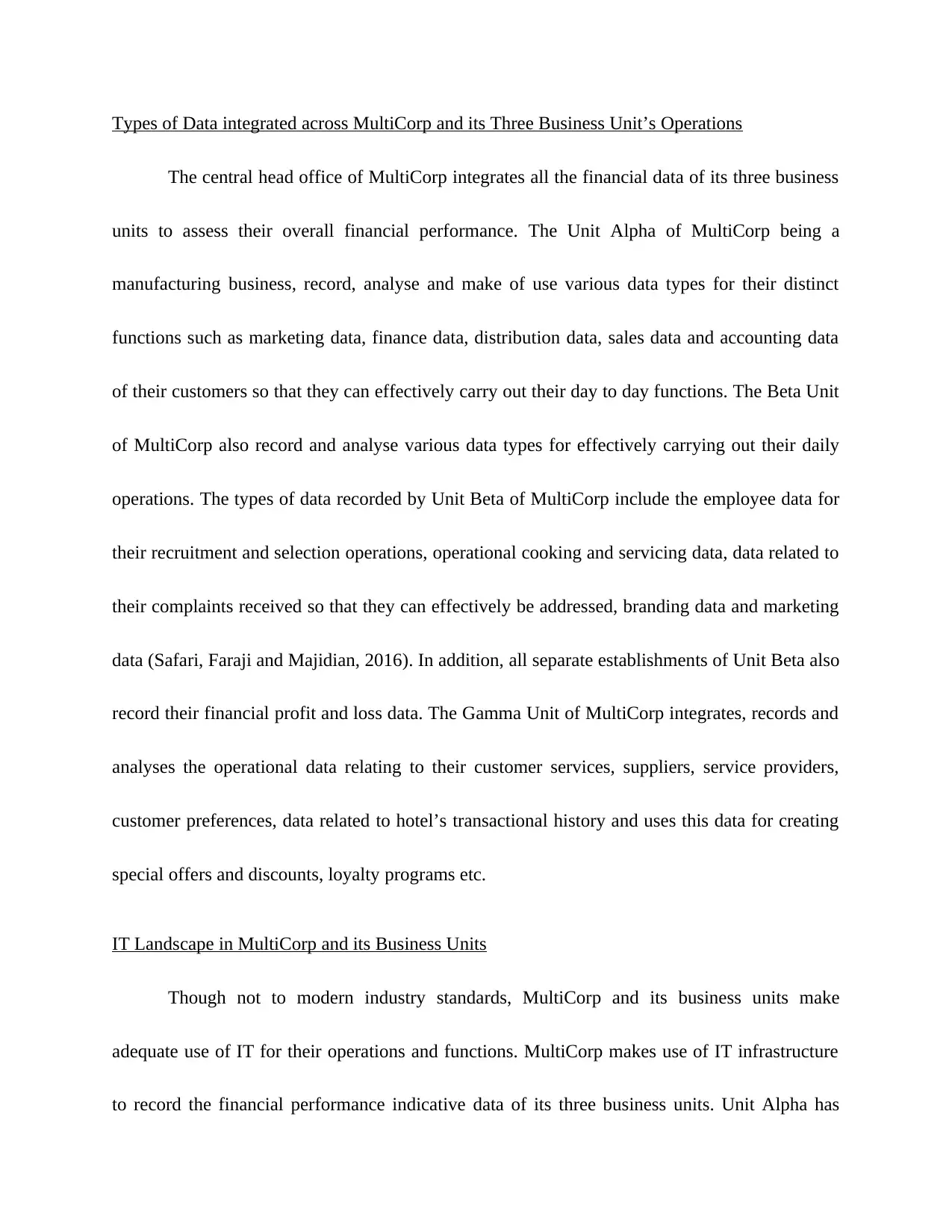
Types of Data integrated across MultiCorp and its Three Business Unit’s Operations
The central head office of MultiCorp integrates all the financial data of its three business
units to assess their overall financial performance. The Unit Alpha of MultiCorp being a
manufacturing business, record, analyse and make of use various data types for their distinct
functions such as marketing data, finance data, distribution data, sales data and accounting data
of their customers so that they can effectively carry out their day to day functions. The Beta Unit
of MultiCorp also record and analyse various data types for effectively carrying out their daily
operations. The types of data recorded by Unit Beta of MultiCorp include the employee data for
their recruitment and selection operations, operational cooking and servicing data, data related to
their complaints received so that they can effectively be addressed, branding data and marketing
data (Safari, Faraji and Majidian, 2016). In addition, all separate establishments of Unit Beta also
record their financial profit and loss data. The Gamma Unit of MultiCorp integrates, records and
analyses the operational data relating to their customer services, suppliers, service providers,
customer preferences, data related to hotel’s transactional history and uses this data for creating
special offers and discounts, loyalty programs etc.
IT Landscape in MultiCorp and its Business Units
Though not to modern industry standards, MultiCorp and its business units make
adequate use of IT for their operations and functions. MultiCorp makes use of IT infrastructure
to record the financial performance indicative data of its three business units. Unit Alpha has
The central head office of MultiCorp integrates all the financial data of its three business
units to assess their overall financial performance. The Unit Alpha of MultiCorp being a
manufacturing business, record, analyse and make of use various data types for their distinct
functions such as marketing data, finance data, distribution data, sales data and accounting data
of their customers so that they can effectively carry out their day to day functions. The Beta Unit
of MultiCorp also record and analyse various data types for effectively carrying out their daily
operations. The types of data recorded by Unit Beta of MultiCorp include the employee data for
their recruitment and selection operations, operational cooking and servicing data, data related to
their complaints received so that they can effectively be addressed, branding data and marketing
data (Safari, Faraji and Majidian, 2016). In addition, all separate establishments of Unit Beta also
record their financial profit and loss data. The Gamma Unit of MultiCorp integrates, records and
analyses the operational data relating to their customer services, suppliers, service providers,
customer preferences, data related to hotel’s transactional history and uses this data for creating
special offers and discounts, loyalty programs etc.
IT Landscape in MultiCorp and its Business Units
Though not to modern industry standards, MultiCorp and its business units make
adequate use of IT for their operations and functions. MultiCorp makes use of IT infrastructure
to record the financial performance indicative data of its three business units. Unit Alpha has
Paraphrase This Document
Need a fresh take? Get an instant paraphrase of this document with our AI Paraphraser
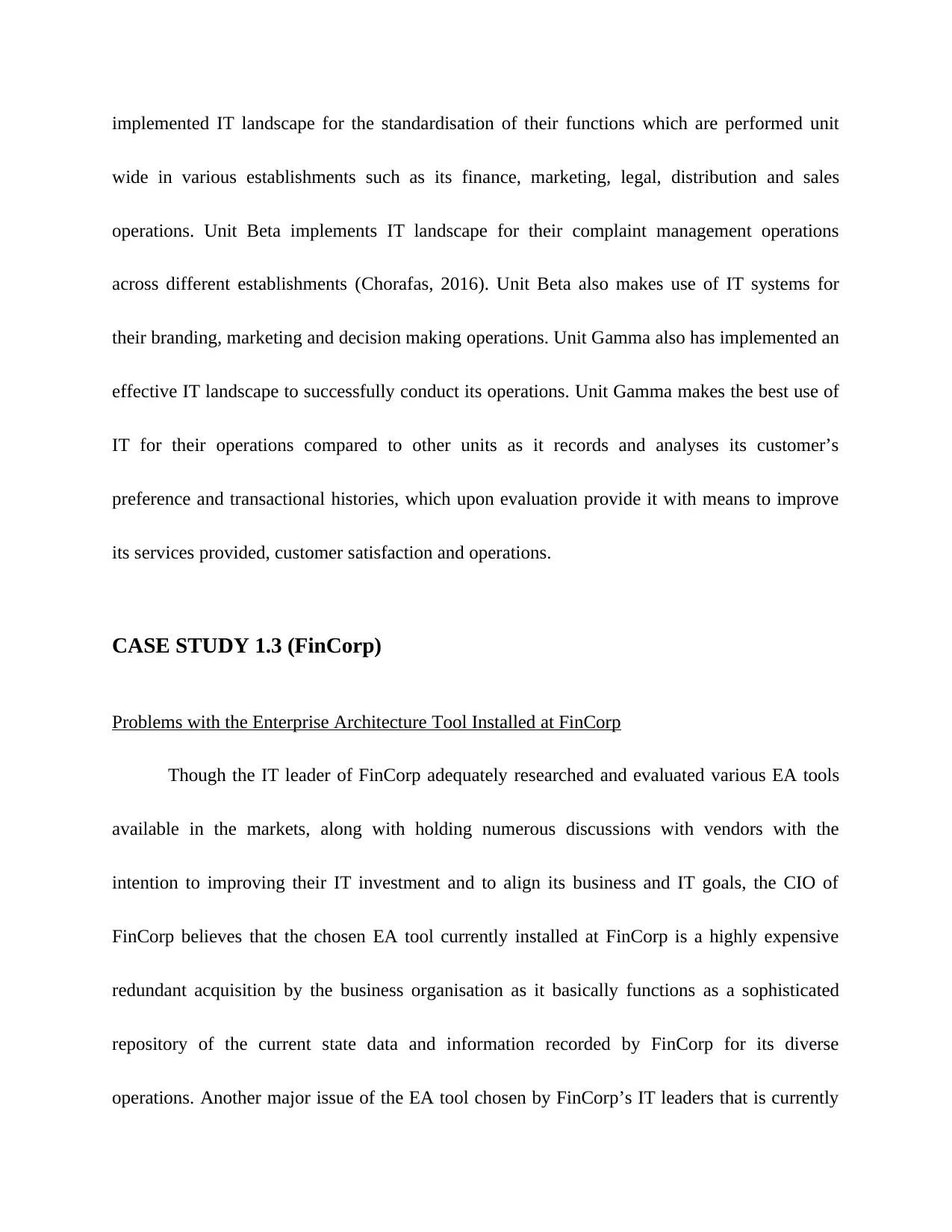
implemented IT landscape for the standardisation of their functions which are performed unit
wide in various establishments such as its finance, marketing, legal, distribution and sales
operations. Unit Beta implements IT landscape for their complaint management operations
across different establishments (Chorafas, 2016). Unit Beta also makes use of IT systems for
their branding, marketing and decision making operations. Unit Gamma also has implemented an
effective IT landscape to successfully conduct its operations. Unit Gamma makes the best use of
IT for their operations compared to other units as it records and analyses its customer’s
preference and transactional histories, which upon evaluation provide it with means to improve
its services provided, customer satisfaction and operations.
CASE STUDY 1.3 (FinCorp)
Problems with the Enterprise Architecture Tool Installed at FinCorp
Though the IT leader of FinCorp adequately researched and evaluated various EA tools
available in the markets, along with holding numerous discussions with vendors with the
intention to improving their IT investment and to align its business and IT goals, the CIO of
FinCorp believes that the chosen EA tool currently installed at FinCorp is a highly expensive
redundant acquisition by the business organisation as it basically functions as a sophisticated
repository of the current state data and information recorded by FinCorp for its diverse
operations. Another major issue of the EA tool chosen by FinCorp’s IT leaders that is currently
wide in various establishments such as its finance, marketing, legal, distribution and sales
operations. Unit Beta implements IT landscape for their complaint management operations
across different establishments (Chorafas, 2016). Unit Beta also makes use of IT systems for
their branding, marketing and decision making operations. Unit Gamma also has implemented an
effective IT landscape to successfully conduct its operations. Unit Gamma makes the best use of
IT for their operations compared to other units as it records and analyses its customer’s
preference and transactional histories, which upon evaluation provide it with means to improve
its services provided, customer satisfaction and operations.
CASE STUDY 1.3 (FinCorp)
Problems with the Enterprise Architecture Tool Installed at FinCorp
Though the IT leader of FinCorp adequately researched and evaluated various EA tools
available in the markets, along with holding numerous discussions with vendors with the
intention to improving their IT investment and to align its business and IT goals, the CIO of
FinCorp believes that the chosen EA tool currently installed at FinCorp is a highly expensive
redundant acquisition by the business organisation as it basically functions as a sophisticated
repository of the current state data and information recorded by FinCorp for its diverse
operations. Another major issue of the EA tool chosen by FinCorp’s IT leaders that is currently

installed is its capability to only be used by the organisational architects which only amount to 4
to 5 individuals in the entire FinCorp organisation (Dang, and Pekkola, 2017). As it can only be
operated by select number of individuals, it does not enhance the decision making capabilities of
FinCorp and its stakeholders at all. The EA tool chosen by FinCorp’s IT leaders also does not
make any contributions towards FinCorp achieving its end objectives and goals which was the
entire point of investing into FinCorp’s EA as its intention was to align its business and IT
operations towards achieving FinCorp’s end goals and objectives.
Value to EA Tool Installed at FinCorp towards its Enterprise Architecture
Though the EA tool installed at FinCorp was an expensive investment, it does provide
value to the operations and functions of FinCorp allowing it to perform IT tasks and computation
that FinCorp was previously incapable of. The EA tool currently installed at FinCorp does
improve upon its past IT capabilities and provide value to the FinCorp business organisation,
increasing its operational performance, efficiency, productivity and profitability in the consumer
markets. As the EA tool is specifically configured to the operations and functions performed by
FinCorp for it improves upon the previous performance and efficiency levels of those operations
and processes and allows them to perform IT tasks they were previously incapable of,
diversifying their operations (Lange, Mendling and Recker, 2016). The central repository that
was installed at FinCorp to effectively install its EA tool also adds value as it allows FinCorp to
to 5 individuals in the entire FinCorp organisation (Dang, and Pekkola, 2017). As it can only be
operated by select number of individuals, it does not enhance the decision making capabilities of
FinCorp and its stakeholders at all. The EA tool chosen by FinCorp’s IT leaders also does not
make any contributions towards FinCorp achieving its end objectives and goals which was the
entire point of investing into FinCorp’s EA as its intention was to align its business and IT
operations towards achieving FinCorp’s end goals and objectives.
Value to EA Tool Installed at FinCorp towards its Enterprise Architecture
Though the EA tool installed at FinCorp was an expensive investment, it does provide
value to the operations and functions of FinCorp allowing it to perform IT tasks and computation
that FinCorp was previously incapable of. The EA tool currently installed at FinCorp does
improve upon its past IT capabilities and provide value to the FinCorp business organisation,
increasing its operational performance, efficiency, productivity and profitability in the consumer
markets. As the EA tool is specifically configured to the operations and functions performed by
FinCorp for it improves upon the previous performance and efficiency levels of those operations
and processes and allows them to perform IT tasks they were previously incapable of,
diversifying their operations (Lange, Mendling and Recker, 2016). The central repository that
was installed at FinCorp to effectively install its EA tool also adds value as it allows FinCorp to
⊘ This is a preview!⊘
Do you want full access?
Subscribe today to unlock all pages.

Trusted by 1+ million students worldwide

record and store its operational and architectural data and information which can be further
analysed by FinCorp to improve and enhance their operations and functions.
Use of EA Tool at FinCorp to Facilitate its IT and Business Alignment
The EA tool that is currently installed at FinCorp does not align its IT and business
operations and functions. This can be improved so that the business and IT operations of FinCorp
are strategically aligned to benefit the entire FinCorp organisation by having the business and IT
leaders of FinCorp identify the end goals and objectives that they have to achieve and then align
them together by making use of the now installed EA tool to effectively facilitate the integration
and alignment of FinCorp’s distinct business and IT operations. Doing so will effectively
facilitate the alignment of its business and IT operations and allow for FinCorp to operate with
increased performance and efficiency allowing it to effectively achieve its end objectives and
goals.
Maximising the Value of EA Tool Installed at FinCorp
Though the EA tool that is currently installed is adequate and configured to the specific
operations and functions of FinCorp, the value that it provides to enhancing and improving the
operations and functions of FinCorp can further be increased to achieve maximum value, as it
was quite and expensive investment. FinCorp’s IT leaders can make use of the EA tool to
increase the decision making capabilities of FinCorp and its business stakeholders, improving the
analysed by FinCorp to improve and enhance their operations and functions.
Use of EA Tool at FinCorp to Facilitate its IT and Business Alignment
The EA tool that is currently installed at FinCorp does not align its IT and business
operations and functions. This can be improved so that the business and IT operations of FinCorp
are strategically aligned to benefit the entire FinCorp organisation by having the business and IT
leaders of FinCorp identify the end goals and objectives that they have to achieve and then align
them together by making use of the now installed EA tool to effectively facilitate the integration
and alignment of FinCorp’s distinct business and IT operations. Doing so will effectively
facilitate the alignment of its business and IT operations and allow for FinCorp to operate with
increased performance and efficiency allowing it to effectively achieve its end objectives and
goals.
Maximising the Value of EA Tool Installed at FinCorp
Though the EA tool that is currently installed is adequate and configured to the specific
operations and functions of FinCorp, the value that it provides to enhancing and improving the
operations and functions of FinCorp can further be increased to achieve maximum value, as it
was quite and expensive investment. FinCorp’s IT leaders can make use of the EA tool to
increase the decision making capabilities of FinCorp and its business stakeholders, improving the
Paraphrase This Document
Need a fresh take? Get an instant paraphrase of this document with our AI Paraphraser
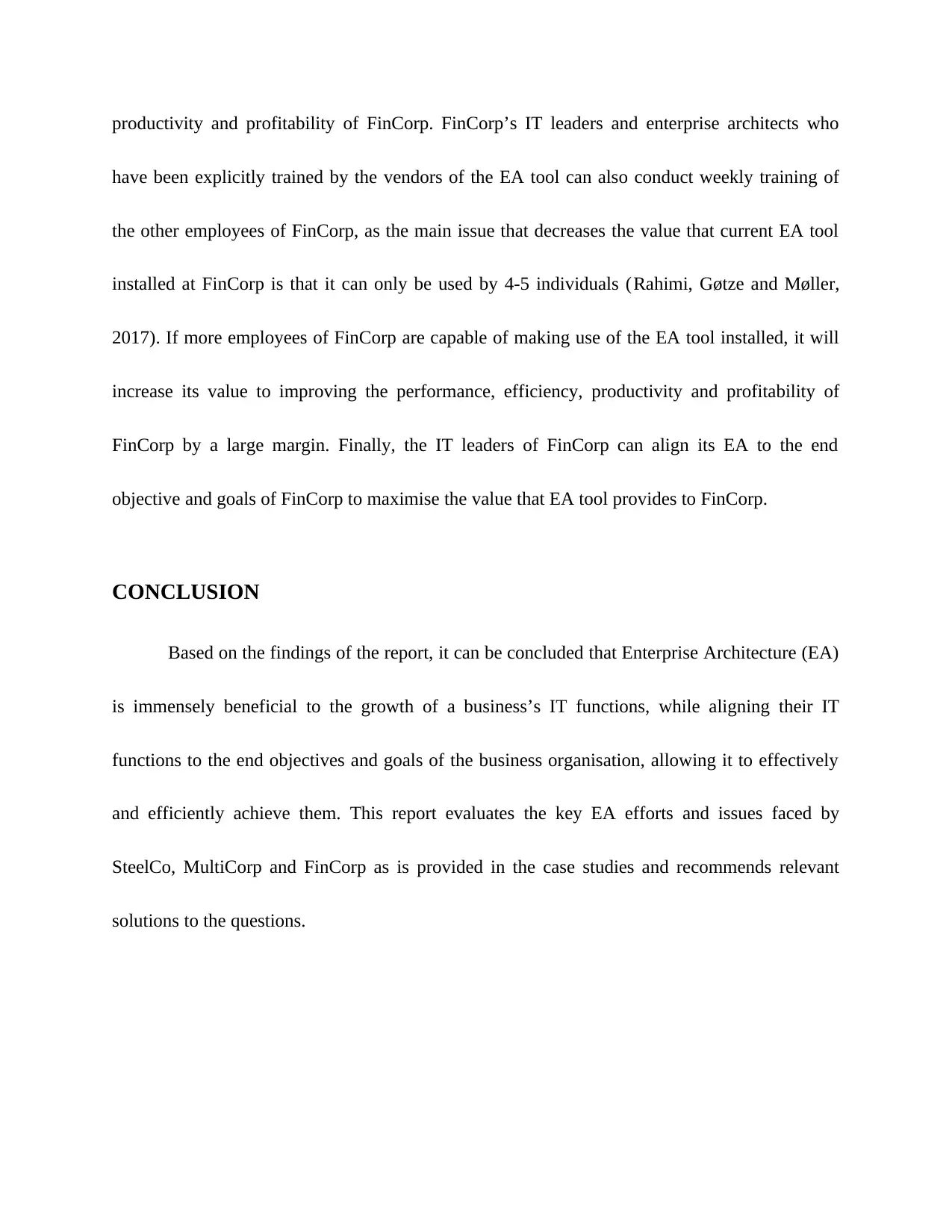
productivity and profitability of FinCorp. FinCorp’s IT leaders and enterprise architects who
have been explicitly trained by the vendors of the EA tool can also conduct weekly training of
the other employees of FinCorp, as the main issue that decreases the value that current EA tool
installed at FinCorp is that it can only be used by 4-5 individuals (Rahimi, Gøtze and Møller,
2017). If more employees of FinCorp are capable of making use of the EA tool installed, it will
increase its value to improving the performance, efficiency, productivity and profitability of
FinCorp by a large margin. Finally, the IT leaders of FinCorp can align its EA to the end
objective and goals of FinCorp to maximise the value that EA tool provides to FinCorp.
CONCLUSION
Based on the findings of the report, it can be concluded that Enterprise Architecture (EA)
is immensely beneficial to the growth of a business’s IT functions, while aligning their IT
functions to the end objectives and goals of the business organisation, allowing it to effectively
and efficiently achieve them. This report evaluates the key EA efforts and issues faced by
SteelCo, MultiCorp and FinCorp as is provided in the case studies and recommends relevant
solutions to the questions.
have been explicitly trained by the vendors of the EA tool can also conduct weekly training of
the other employees of FinCorp, as the main issue that decreases the value that current EA tool
installed at FinCorp is that it can only be used by 4-5 individuals (Rahimi, Gøtze and Møller,
2017). If more employees of FinCorp are capable of making use of the EA tool installed, it will
increase its value to improving the performance, efficiency, productivity and profitability of
FinCorp by a large margin. Finally, the IT leaders of FinCorp can align its EA to the end
objective and goals of FinCorp to maximise the value that EA tool provides to FinCorp.
CONCLUSION
Based on the findings of the report, it can be concluded that Enterprise Architecture (EA)
is immensely beneficial to the growth of a business’s IT functions, while aligning their IT
functions to the end objectives and goals of the business organisation, allowing it to effectively
and efficiently achieve them. This report evaluates the key EA efforts and issues faced by
SteelCo, MultiCorp and FinCorp as is provided in the case studies and recommends relevant
solutions to the questions.
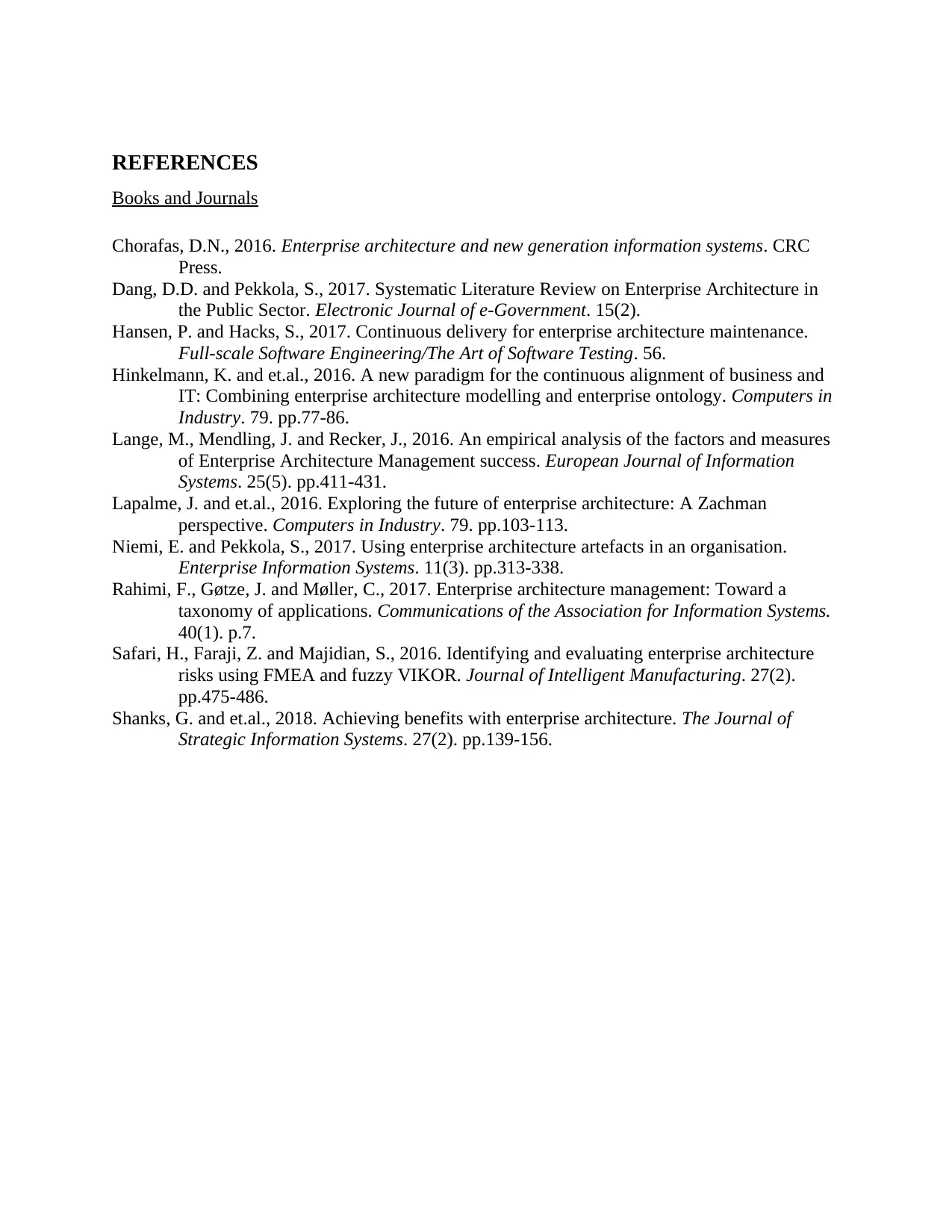
REFERENCES
Books and Journals
Chorafas, D.N., 2016. Enterprise architecture and new generation information systems. CRC
Press.
Dang, D.D. and Pekkola, S., 2017. Systematic Literature Review on Enterprise Architecture in
the Public Sector. Electronic Journal of e-Government. 15(2).
Hansen, P. and Hacks, S., 2017. Continuous delivery for enterprise architecture maintenance.
Full-scale Software Engineering/The Art of Software Testing. 56.
Hinkelmann, K. and et.al., 2016. A new paradigm for the continuous alignment of business and
IT: Combining enterprise architecture modelling and enterprise ontology. Computers in
Industry. 79. pp.77-86.
Lange, M., Mendling, J. and Recker, J., 2016. An empirical analysis of the factors and measures
of Enterprise Architecture Management success. European Journal of Information
Systems. 25(5). pp.411-431.
Lapalme, J. and et.al., 2016. Exploring the future of enterprise architecture: A Zachman
perspective. Computers in Industry. 79. pp.103-113.
Niemi, E. and Pekkola, S., 2017. Using enterprise architecture artefacts in an organisation.
Enterprise Information Systems. 11(3). pp.313-338.
Rahimi, F., Gøtze, J. and Møller, C., 2017. Enterprise architecture management: Toward a
taxonomy of applications. Communications of the Association for Information Systems.
40(1). p.7.
Safari, H., Faraji, Z. and Majidian, S., 2016. Identifying and evaluating enterprise architecture
risks using FMEA and fuzzy VIKOR. Journal of Intelligent Manufacturing. 27(2).
pp.475-486.
Shanks, G. and et.al., 2018. Achieving benefits with enterprise architecture. The Journal of
Strategic Information Systems. 27(2). pp.139-156.
Books and Journals
Chorafas, D.N., 2016. Enterprise architecture and new generation information systems. CRC
Press.
Dang, D.D. and Pekkola, S., 2017. Systematic Literature Review on Enterprise Architecture in
the Public Sector. Electronic Journal of e-Government. 15(2).
Hansen, P. and Hacks, S., 2017. Continuous delivery for enterprise architecture maintenance.
Full-scale Software Engineering/The Art of Software Testing. 56.
Hinkelmann, K. and et.al., 2016. A new paradigm for the continuous alignment of business and
IT: Combining enterprise architecture modelling and enterprise ontology. Computers in
Industry. 79. pp.77-86.
Lange, M., Mendling, J. and Recker, J., 2016. An empirical analysis of the factors and measures
of Enterprise Architecture Management success. European Journal of Information
Systems. 25(5). pp.411-431.
Lapalme, J. and et.al., 2016. Exploring the future of enterprise architecture: A Zachman
perspective. Computers in Industry. 79. pp.103-113.
Niemi, E. and Pekkola, S., 2017. Using enterprise architecture artefacts in an organisation.
Enterprise Information Systems. 11(3). pp.313-338.
Rahimi, F., Gøtze, J. and Møller, C., 2017. Enterprise architecture management: Toward a
taxonomy of applications. Communications of the Association for Information Systems.
40(1). p.7.
Safari, H., Faraji, Z. and Majidian, S., 2016. Identifying and evaluating enterprise architecture
risks using FMEA and fuzzy VIKOR. Journal of Intelligent Manufacturing. 27(2).
pp.475-486.
Shanks, G. and et.al., 2018. Achieving benefits with enterprise architecture. The Journal of
Strategic Information Systems. 27(2). pp.139-156.
⊘ This is a preview!⊘
Do you want full access?
Subscribe today to unlock all pages.

Trusted by 1+ million students worldwide
1 out of 13
Related Documents
Your All-in-One AI-Powered Toolkit for Academic Success.
+13062052269
info@desklib.com
Available 24*7 on WhatsApp / Email
![[object Object]](/_next/static/media/star-bottom.7253800d.svg)
Unlock your academic potential
Copyright © 2020–2025 A2Z Services. All Rights Reserved. Developed and managed by ZUCOL.





